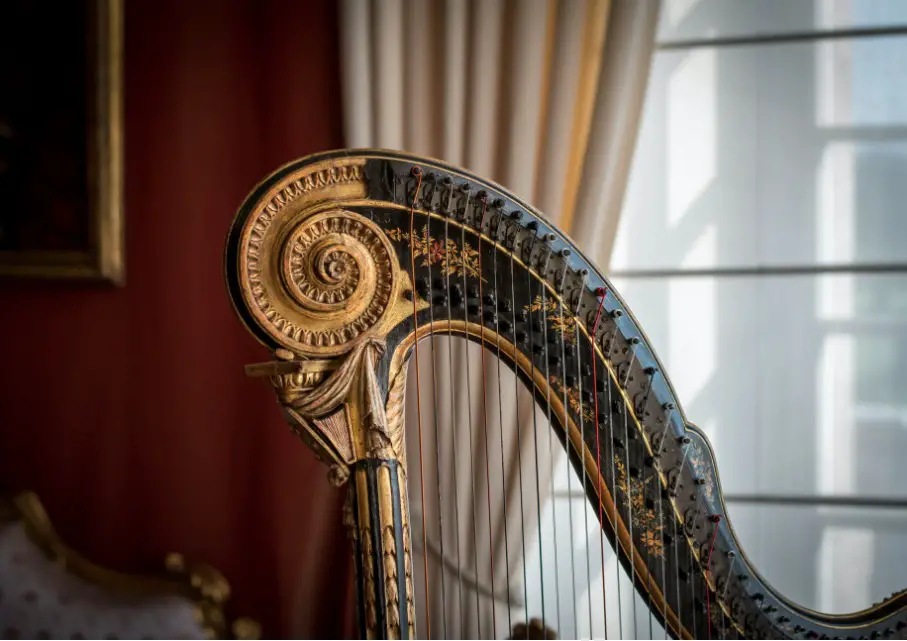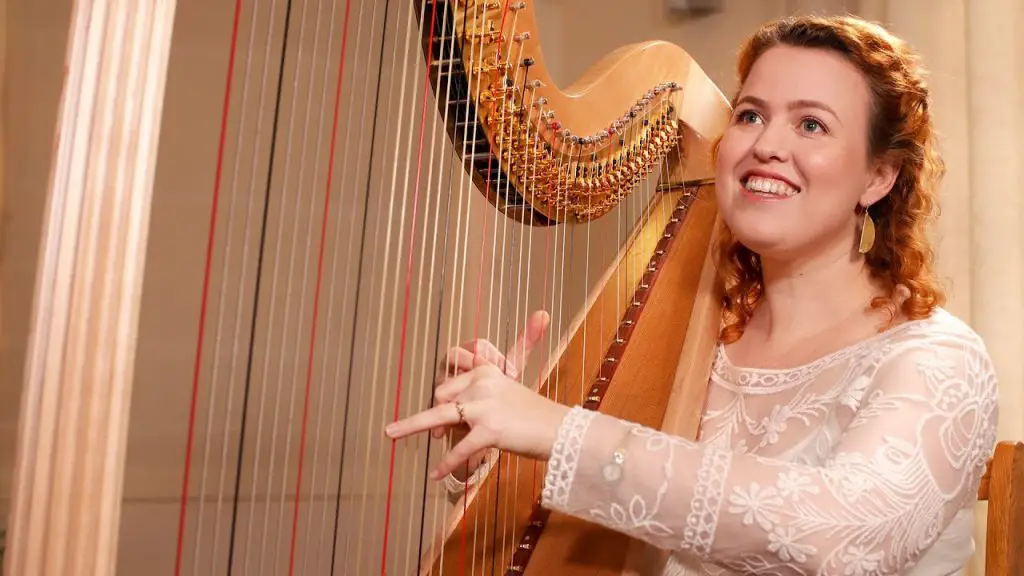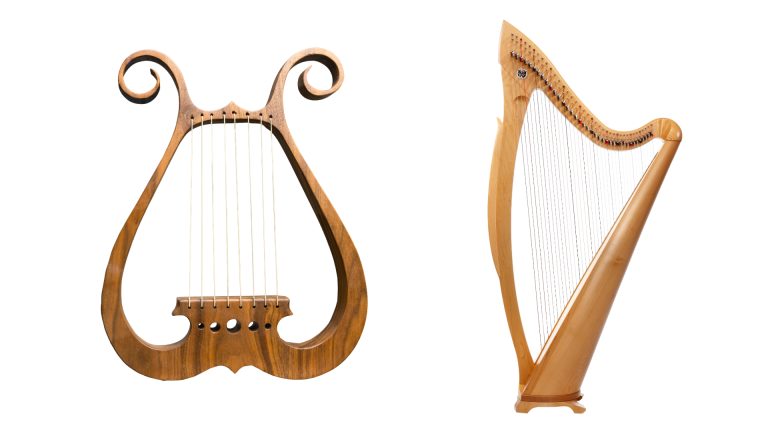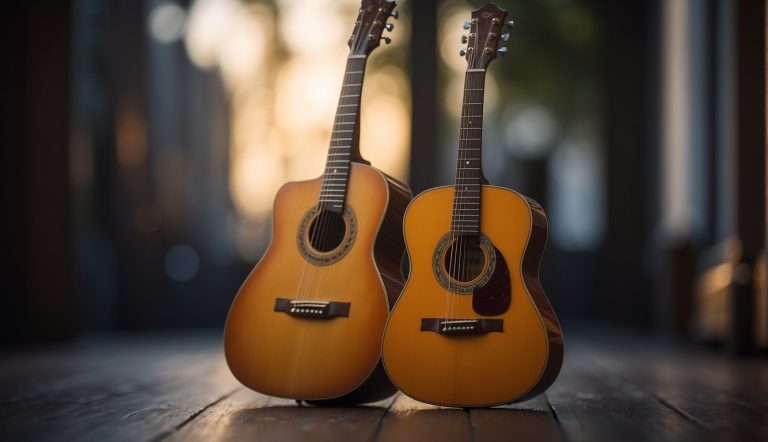What Is the Posture for Playing the Harp: Essential Tips for Beginners
Folkstrings.com is reader-supported. When you buy through links on our site, we may earn a small commission.
When I first began learning the harp, understanding proper posture was pivotal for efficient practice and performance.
The interaction between a harpist and their instrument demands a particular physical alignment to play comfortably and effectively.
I quickly learned that maintaining a good posture ensures that I play without unnecessary tension and with better control of the strings.
The general posture involves sitting at 90 degrees to the harp, with the instrument’s back resting against the shoulder.
This ensures the arms are free to move, and the fingers can pluck the strings with precision.

Subtle adjustments to my sitting position made a significant impact on my technique.
For example, aligning my fingers on the strings and adjusting my elbow height affected the sound quality and ease of playing.
Beyond the basic posture, the nuances of hand positioning, finger movement, and even how to manage environmental variables like extreme temperatures or lighting at a performance venue influence my harp playing experience.
It’s essential for beginners like me to learn these fundamental principles early in their harp education to lay a strong foundation for future development.
Key Points
- Adopting correct posture is crucial for playing the harp comfortably and effectively.
- Subtle adjustments in positioning can significantly impact technique and sound quality.
- Early mastery of posture and positioning benefits lifelong learning and teaching of the harp.
Table of Contents
Fundamentals of Harp Posture
Mastering the art of playing the harp starts with the foundation of good posture. A well-defined posture is crucial not only to produce a beautiful tone but also to avoid strain and injury over time.
Understanding Harp Posture
Harp posture is about balance and relaxation. As a harpist, I need to sit so my spine is aligned and my weight is distributed evenly across my sitting bones. Maintaining this equilibrium allows me to play for longer periods without discomfort.
Sitting and Hand Position
I sit at the harp with my back straight and shoulders relaxed, ensuring my feet can reach the pedals comfortably if I’m playing a pedal harp.
My hands should be in a relaxed position with curved fingers, and my elbows slightly lifted to allow freedom of movement.
Ergonomics and Injury Prevention
Good posture goes hand in hand with injury prevention. Playing with tension can lead to pain, so I focus on relaxation in my technique.
I also make sure my harp is adjusted to fit my body correctly. This may involve altering the height or tilt of the harp for optimal comfort.
Choosing the Right Harp
The type of harp I choose—be it a pedal harp, lever harp, lap harp, or Celtic harp—impacts my posture.
I must ensure the instrument suits my body size and the kind of music I want to learn, as each type requires subtle differences in technique and posture.
Setting Up Your Practice Space
A well-organized practice space is essential. I make sure my chair and music stand are at the right height, and the lighting is sufficient.
Having everything within easy reach minimizes unnecessary movement that could disrupt my posture.
Instrument Care and Tuning
Regular maintenance, including careful tuning of my harp’s strings, directly affects the ease with which I can play.
A well-maintained harp responds better and supports correct hand positioning and posture.
Basic Playing Techniques
Developing sound harp technique starts with simple fingering, scales, arpeggios, and chords.
I give attention to my hand position and the way I pluck the strings to produce a clear tone while staying relaxed.
Learning To Read Music
The ability to read sheet music is fundamental.
I practice reading notes and interpreting signs and markings efficiently, which helps me stay focused on maintaining good posture.
Warm-Up Exercises
I begin every practice session with warm-up exercises.
These exercises can range from simple finger stretches to playing scales. They prepare my hands and body for playing and reinforce the importance of relaxation and strength.
Starting Your Learning Journey
For beginners, I advise finding a qualified harp teacher.
Learning the correct posture and technique from the start lays the groundwork for a fulfilling journey with the harp.
Engaging With The Harp Community
I find support and inspiration in the harp community.
Connecting with other harpists, from students to professionals, is a great way to exchange tips on posture and technique, and it helps me stay motivated.
Advanced Techniques and Performance

In the nuanced world of harp playing, advancing one’s technique and delivering captivating performances requires a deliberate focus on refining skills and creative expression.
We’ll explore various aspects of advanced harp playing and how they contribute to a performer’s growth and the enchanting allure of their music.
Refining Hand Technique and Tone
I find that hand position is critical in achieving a clear and resonant tone in harp playing.
Regular exercises aimed at strengthening fingers and ensuring flexibility can significantly improve precision and agility.
For instance, rotating the wrist gently and maintaining an open, slanted hand position aids in fluid motion across the strings, enhancing tone quality.
Mastering Pedal and Lever Changes
Pedal harps and lever harps demand distinct approaches for changes during play.
On a pedal harp, I use my feet to alter pitch with swift and discreet pedal movements, ensuring transitions are seamless and don’t disrupt the flow of performance.
On a lever harp, my hand movements are well-timed to flip the levers without affecting the ongoing melody.
Exploring Advanced Repertoire
Venturing into complex classical music pieces, I challenge my technical limits and interpretative skills.
This involves not only learning the notes but also understanding the composer’s intent, the piece’s structure, and the emotions it seeks to convey, allowing for a nuanced and rich performance.
Performance Preparation
To combat performance anxiety, I adopt various methods to boost my confidence.
I ensure ample practice, understand the venue’s acoustics, try recording myself to self-critique, and conduct thorough sound checks.
I also visualize the performance, which helps me stay calm and focused during the actual event.
Creative Expression and Composition
As for composition and creativity, I draw upon my experience and the vast palette of harp sounds to create original works.
I experiment with different techniques, seeking new sounds, and embrace the harp’s versatility, creating compositions that resonate with my personal style and creativity.
Presenting and Collaborating
Collaboration offers fresh perspectives and pushes the boundaries of traditional harp playing.
Whether it’s performing at weddings, events, or working with other artists, I find that openness to new ideas and styles fosters a rich environment for creativity.
Networking with peers and sharing techniques also contribute to a vibrant harp community.
Lifelong Learning and Teaching
In my journey as a harpist, I’ve found that continuous learning and teaching are intertwined with building a fulfilling career.
Pursuing Continual Education
As a professional harpist, I never stop seeking out new knowledge.
Courses and online harp lessons have been invaluable, allowing me to refine my technique and expand my repertoire.
I regularly set goals for my practice sessions to ensure I’m progressing.
Overcoming Plateaus
Every harpist encounters plateaus.
When my growth seems to stall, I shake up my routine, setting fresh challenges to push past these hurdles.
It’s essential for my mental health to recognize these plateaus as part of the learning process.
Teaching Harp to Others
Teaching is a rewarding experience that hones my own skills.
I impart not just techniques but also the importance of the correct playing posture to my students.
By guiding them through their harp journey, I reinforce my understanding and feel pride in their achievements.
Building a Career as a Harpist
Creating a career path requires more than just talent; it involves strategic planning and networking.
Attending events and collaborating with other musicians provide opportunities that can lead to becoming an award-winning harpist.
Connecting With a Global Community
I’m part of a supportive community where collaboration is a cornerstone.
Online platforms allow me to share my experiences and learn from fellow harpists worldwide, which is incredibly inspiring.
Recognition and Competitions
Competitions have been a platform for me to gain recognition and showcase my skills.
Preparing for these events is an intense learning experience that pushes me to excel and often leads to unexpected opportunities.
Frequently Asked Questions
In my experience, having correct posture and hand position can greatly affect your performance and health as a harpist.
How do I maintain the correct hand position while playing the harp?
To maintain the correct hand position, you should keep your fingers relaxed and slightly curved.
Position the hands with the palms facing inward and ensure your thumbs are higher than your fingers when plucking the strings.
What are the proper techniques for plucking a harp?
Plucking requires a gentle yet firm movement.
My technique involves using the pads of my fingers to pull the strings towards me smoothly, then releasing them swiftly to avoid dampening the sound. Proper wrist positioning aids in avoiding injury.
Could you explain the ideal finger placement for harpists?
Ideal finger placement on the harp includes keeping the fingers close to the strings with their tips pointing downwards.
My fingers should approach the strings at an angle that allows for a secure connection without unnecessary tension.
In what position should a lap harp be held when played?
When playing a lap harp, I sit straight and hold the instrument’s base firmly with my knees, ensuring the harp is steady and tilted slightly toward me for easier access to the strings.
How should I position my body when playing the harp to promote good posture?
I always make sure to sit erect on the edge of my seat, feet flat on the floor, with the harp resting between my shoulder and the right knee.
Maintaining this posture reduces strain on my back and allows for freer arm movement.
Why is the harp typically held at a tilt during performances?
The tilt allows for better visual and physical access to the strings. This enhances accuracy and technique.
I hold my harp at a tilt. I align it with my shoulder to avoid overreaching. This ensures more comfortable and efficient play.
Author Profile
-
Daniel Johnstone is an English writer with a love for stringed instruments from around the world.
He shares his love for these instruments through his writing for folkstrings.com, a website dedicated to all things related to folk string music.
Daniel's passion for music started at a young age, and he has since become an accomplished musician, playing guitar, cavaco, and recently, the harp.
His dedication to learning and sharing his knowledge of stringed instruments is evident in his insightful and engaging blog posts. Whether you're a seasoned musician or a beginner, Daniel's writing is sure to inspire and entertain you.
When he's not playing music or writing, you can find Daniel exploring new instruments and seeking out new sounds to share with his readers.
Latest entries
 AutoharpApril 4, 2024What Is the Autoharp Made Of: Exploring Its Materials and Craftsmanship
AutoharpApril 4, 2024What Is the Autoharp Made Of: Exploring Its Materials and Craftsmanship AutoharpApril 4, 2024Is Autoharp Easy to Play? Unveiling the Truth for Beginners
AutoharpApril 4, 2024Is Autoharp Easy to Play? Unveiling the Truth for Beginners AutoharpApril 4, 2024What Is an Autoharp Worth? Your Guide to Pricing and Value
AutoharpApril 4, 2024What Is an Autoharp Worth? Your Guide to Pricing and Value AutoharpApril 4, 2024Are Autoharp and Zither the Same Thing? Unraveling String Instrument Myths
AutoharpApril 4, 2024Are Autoharp and Zither the Same Thing? Unraveling String Instrument Myths
Affiliates:
This post may contain affiliate links that at no additional cost to you, the site may earn a small commission. We only recommend products we would use ourselves and all opinions expressed on this site are our own.
Accuracy Advice:
While we strive to provide up-to-date and accurate information, the content in this article may not reflect the most current research or medical guidelines. We encourage readers to do further research and consult with professionals for more personalized advice.
Our Recommendations:
The products and services mentioned in any of our articles are recommended based on our independent research and personal experience. We are not sponsored by any company. We aim to suggest products and services we believe are of high quality and could be beneficial to our readers.



